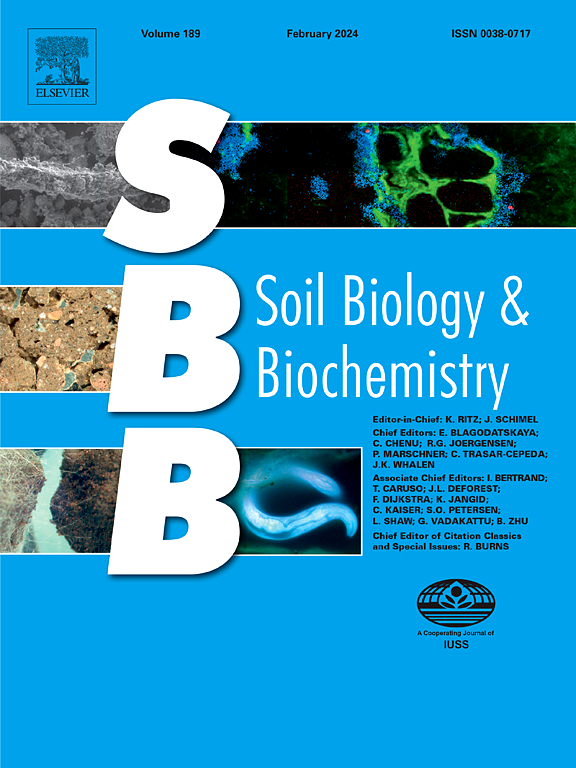Arctic tundra soil depth, more than seasonality, determines active layer bacterial community variation down to the permafrost transition
IF 9.8
1区 农林科学
Q1 SOIL SCIENCE
引用次数: 0
Abstract
Enhanced microbial decomposition of the Arctic’s vast soil carbon pool due to climate warming could result in globally significant CO2/CH4 emissions. Our understanding of tundra soil microbial communities is generally based on studies of either the top surface or the deep frozen permafrost. In contrast, there has been relatively little exploration of bacterial communities and soil biogeochemistry through entire soil depth profiles to the permafrost, and none that has specifically incorporated temporal dynamics with depth as the summer thaw proceeds. Here we report bacterial community composition in 10-cm increments from the surface to the permafrost from late winter through to autumn, at a mesic low Arctic tundra site. Bacterial community composition and phylogenetic diversity varied substantially with soil depth and much less among sampling times. Correlation analysis indicated that the surface organic, subsoil mineral, and permafrost transition soil layers each had distinct community interaction networks. Acidobacteriota-affiliated taxa dominated surface communities but declined significantly with soil depth and increasing pH, while Bacteroidetes taxa relative abundances were also associated with pH, and were largest in the carbon-restricted permafrost transition layer. Thus, patterns in community assembly were primarily associated with depth and correlated with edaphic factors, with relatively little impact of the seasonal changes between frozen and thawed assemblages within each sampling depth interval. Nevertheless, total microbial biomass within each depth interval generally declined during the seasonal transition from frozen to thawed state. Finally, our data indicate that soil pH, which is known to govern tundra microbial community composition horizontally across the surface organic layer at multiple spatial scales, is also an important determinant of vertical differences in bacterial community composition from the surface down to the permafrost.北极冻土层土壤深度比季节性更能决定活动层细菌群落的变化,直至永久冻土过渡阶段
由于气候变暖,北极地区巨大的土壤碳库的微生物分解作用增强,这可能导致全球范围内大量的二氧化碳/四氧化二氮排放。我们对苔原土壤微生物群落的了解通常基于对表层或深冻永久冻土的研究。与此相反,对整个土壤深度剖面到永久冻土层的细菌群落和土壤生物地球化学的研究相对较少,也没有专门研究夏季解冻时随着深度变化的时间动态。在这里,我们报告了从冬末到秋季,在一个中低纬度北极苔原地点,从地表到永久冻土层以 10 厘米为单位的细菌群落组成。细菌群落组成和系统发育多样性随土壤深度变化很大,而采样时间的变化则小得多。相关性分析表明,表层有机土壤、底层矿物土壤和永久冻土过渡土壤层各有不同的群落相互作用网络。酸性菌群类群在表层群落中占主导地位,但随着土壤深度和 pH 值的增加,酸性菌群类群的数量明显减少,而类杆菌群类群的相对丰度也与 pH 值有关,在碳限制的永久冻土过渡层中,类杆菌群类群的数量最多。因此,群落的组合模式主要与深度有关,并与土壤环境因子相关,而在每个取样深度区间内,冰冻和解冻群落之间的季节性变化影响相对较小。不过,在从冻结状态向解冻状态的季节性过渡期间,每个深度区间内的微生物总生物量普遍下降。最后,我们的数据表明,已知土壤 pH 值在多个空间尺度上支配着整个表层有机层的苔原微生物群落水平组成,它也是决定从表层到永久冻土层的细菌群落垂直组成差异的重要因素。
本文章由计算机程序翻译,如有差异,请以英文原文为准。
求助全文
约1分钟内获得全文
求助全文
来源期刊

Soil Biology & Biochemistry
农林科学-土壤科学
CiteScore
16.90
自引率
9.30%
发文量
312
审稿时长
49 days
期刊介绍:
Soil Biology & Biochemistry publishes original research articles of international significance focusing on biological processes in soil and their applications to soil and environmental quality. Major topics include the ecology and biochemical processes of soil organisms, their effects on the environment, and interactions with plants. The journal also welcomes state-of-the-art reviews and discussions on contemporary research in soil biology and biochemistry.
 求助内容:
求助内容: 应助结果提醒方式:
应助结果提醒方式:


